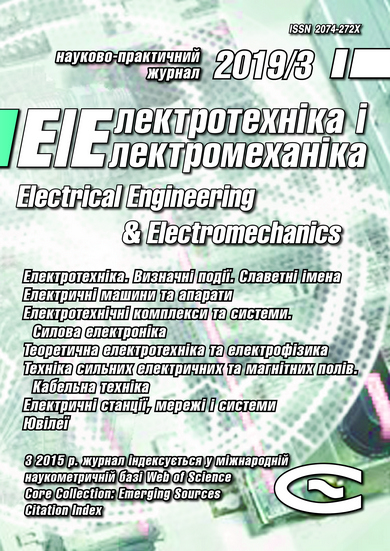HIGH CURRENT HARMONICS INFLUENCE ON THE CHOICE OF CONDUCTORS OF CRANE POWER SUPPLY SYSTEMS
DOI:
https://doi.org/10.20998/2074-272X.2019.3.04Keywords:
high harmonics, voltage losses, power losses, conductors, steel materials, aluminum tires, crane power systemsAbstract
Purpose. To study the effect of high current harmonics on the power and voltage losses in the conductive lines of the crane power supply systems and the development of an account method for this influence in practical calculations. Methodology. For research analytical methods and methods of simulation are used. Results. Analytical calculations have been performed for power losses and voltage losses for the conductors of crane power supply systems in the conditions of high harmonic generation for frequency-controlled drives. Originality. For the first time, the authors have obtained the analytical expressions and graphical dependencies in relative units for practical calculations that allow determining the effect of high harmonics to the values of power losses and voltage losses for crane supply systems, while the parameters of steel conductors are nonlinear for load current and frequency. We have established that the values of power losses and voltage losses increase for crane power supply systems. It is shown that the power losses lead to a decrease the efficiency of crane supply systems up to 7 %, which must be taken into account when choosing electric drive systems and its payback period. Practical value. The obtained theoretical expressions can be used for calculations, design, optimization of crane power supply systems in terms of high harmonic generation.References
Gerasimyak R.P., Busher V.V., Kalinin A.G. Elektroprivody i sistemy upravleniia kranovykh mekhanizmov [Electric drives and control systems of crane mechanisms]. Odessa, Science and Technology Publ., 2014. 202 p. (Rus).
Volkov I.V. The new concept of building power circuits of frequency-controlled asynchronous electric drives. Technical electrodynamics, 1999, no.4, pp. 21-26. (Rus).
Tishchenko V.N., Kolotilo V.I. The current state of electric lifting mechanisms. Transactions of NTU «KhPI». Chapter «Problems of automated electric drive». Theory and practice, 2005, no.45, pp. 303-306. (Rus).
Nemykina O.V. The choice of the power supply system of cranes with variable frequency drive. Electrotechnic and computer systems, 2015, no.19, pp. 54-57. (Rus).
IEEE 519-1992. IEEE Recommended Practices and Requirements for Harmonic Control in Electrical Power Systems, USA, New York, 1993.
IEC 61000-3-12:2012. Electromagnetic compatibility (EMC) of technical equipment. International Standard, 2012.
IEC 61000-3-12:2004. Limitation of emission of harmonic currents in low voltage power supply systems for equipment with rated current greater than 16 A per phase. International Standard, 2004.
Rudnitskiy V.G. Vnutrishnotsehove elektropostachannya. [Innerly electric power supply]. Sumy, University Book Publ., 2007. 280 p. (Ukr).
Spravochnik energetika promyishlennyih predpriyatiy. T.1. Elektrosnabzheniye. [Reference energy industry enterprises. Vol.1. Power supply]. Moscow, Leningrad, Gosenergoizdat Publ., 1961. 840 p. (Rus).
Zhezhelenko I.V., Saenko Yu.L. Pokazateli kachestva i ih kontrol na promyishlennyih predpriyatiyah [Quality indicators and their control at industrial enterprises]. Moscow, Energoatomizdat Publ., 2000. 252 p. (Rus).
Andrienko P.D., Nemykina O.V., Andrienko D.S. Electromagnetic compatibility of power supply systems of cranes with variable frequency drives. Electrical Engineering and Electromechanics. Special edition of the XXII scientific-technical conference Power electronics and energy efficiency, 2016/4(2), vol.2, pp. 109-112. (Rus).
Radimov S.N. Experimental determination of the actual electrical parameters of crane busbars – an informational basis for optimizing their operation. Bulletin of the Odessa National Maritime University, 2001, no.7, pp. 161-168. (Rus).
Downloads
Published
How to Cite
Issue
Section
License
Copyright (c) 2019 P. D. Andrienko, O. V. Nemykina, A. A. Andrienko

This work is licensed under a Creative Commons Attribution-NonCommercial 4.0 International License.
Authors who publish with this journal agree to the following terms:
1. Authors retain copyright and grant the journal right of first publication with the work simultaneously licensed under a Creative Commons Attribution License that allows others to share the work with an acknowledgement of the work's authorship and initial publication in this journal.
2. Authors are able to enter into separate, additional contractual arrangements for the non-exclusive distribution of the journal's published version of the work (e.g., post it to an institutional repository or publish it in a book), with an acknowledgement of its initial publication in this journal.
3. Authors are permitted and encouraged to post their work online (e.g., in institutional repositories or on their website) prior to and during the submission process, as it can lead to productive exchanges, as well as earlier and greater citation of published work.





